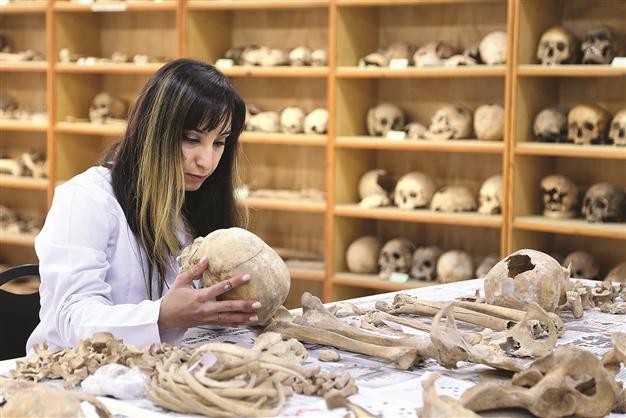Anatolia’s bone collection sheds light on history
ANKARA – Anadolu Agency

A bone collection at a laboratory at Hacettepe University's Anthropology Department has drawn great interest from national and international researchers, as it reveals the structure of ancient societies. AA Photo
With a collection of around 10,000 human skeletons from the earliest sands of time to the Middle Ages, the Hacettepe University Anthropology Laboratory is continuing to draw researchers from around the world thanks to the insights the remains offer about the ancient world.
The head of the Anthropology Department of the university, Professor Yılmaz Selim Erdal, said the lab was home to the remains of skeletons from 45 settlements and that they were used to obtain data about the population structure of ancient societies, nutrition models, lifestyles, population relations and health structures.
Erdal said all situations that people had encountered in their life were reflected in their skeletons, meaning researchers today could glean information about sex, genetic function and the general structure and population of the ancient communities.
“The laboratory is famous for protecting the biggest skeleton population of Anatolia,” he said. “We have 80 percent of the Neolithic skeleton population that have been revealed in Anatolia.”
Erdal said the examinations of the skeleton remains had led them to understand how sedentary life had begun and its effects on people. “We don’t have too many materials from the Chalcolithic period, but we have many skeleton groups from the Bronze Age, the beginning of urbanization. Most of the other groups represent Roman and Middle Age groups,” he said.
Scientists did not discover the important skeletons could have on revealing ancient societies until the 1960s, Erdal said.
Archaeological excavations in Turkey were accelerated after the 1960s, he said. “In this sense, Turkey has become one of the most important centers in Europe and the Middle East. Almost all skeleton groups found in Turkish excavations are being protected. It has drawn the attention of all national and international researchers.”
Erdal said some diseases like leprosy, tuberculosis and the pox had left marks on their bones, adding that testing had appeared to prove wrong previous theses that pox had been brought to the old world with the return of Christopher Columbus and his crew.
“The work is important since it reveals that the disease, which dates back to the pre-Columbian era, could have existed in Anatolia, too,” the academic said.
Research shows that skulls were slowly given a new form because of the way people wrapped their heads, Erdal said.
“This is the same as the tradition of head covering in today’s Anatolia. The form of the skull is changed because a wide forehead is important in Anatolia. People try to widen their forehead to be seen as more beautiful and do so by wrapping their head. As soon as the child is born, they wrap the head.”
Professor Caitlin Pepperell of the University of Wisconsin School of Medicine and Public Health said she had come to see the rich skeleton collection in the laboratory.
She said she had a special interest in tuberculosis, one of the big health problems in the world, and that the bone collection at the laboratory was critical for their work.
“This is a special collection and not only the material but the experts’ way of defining and interpreting the material is very special,” she said.
